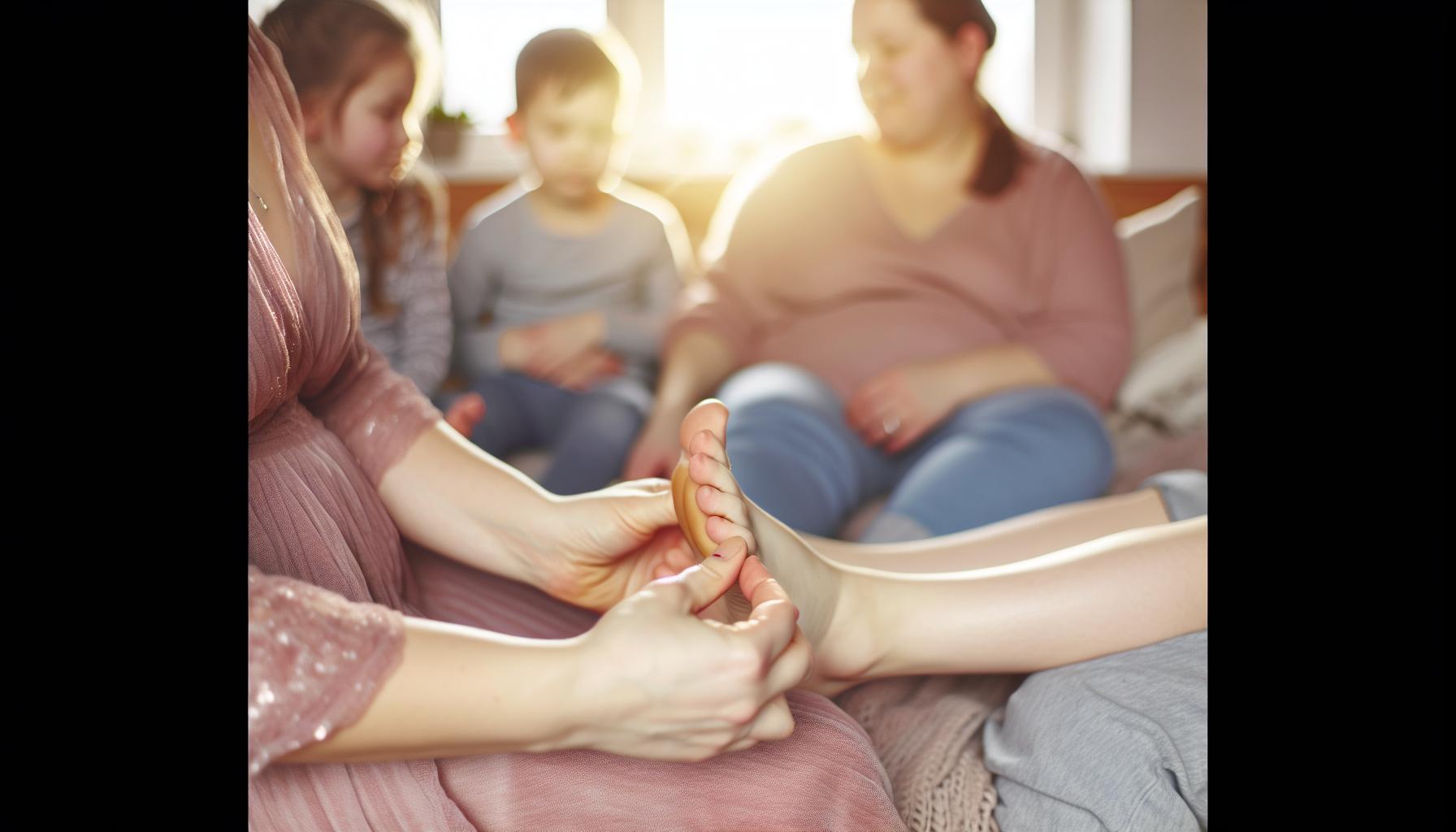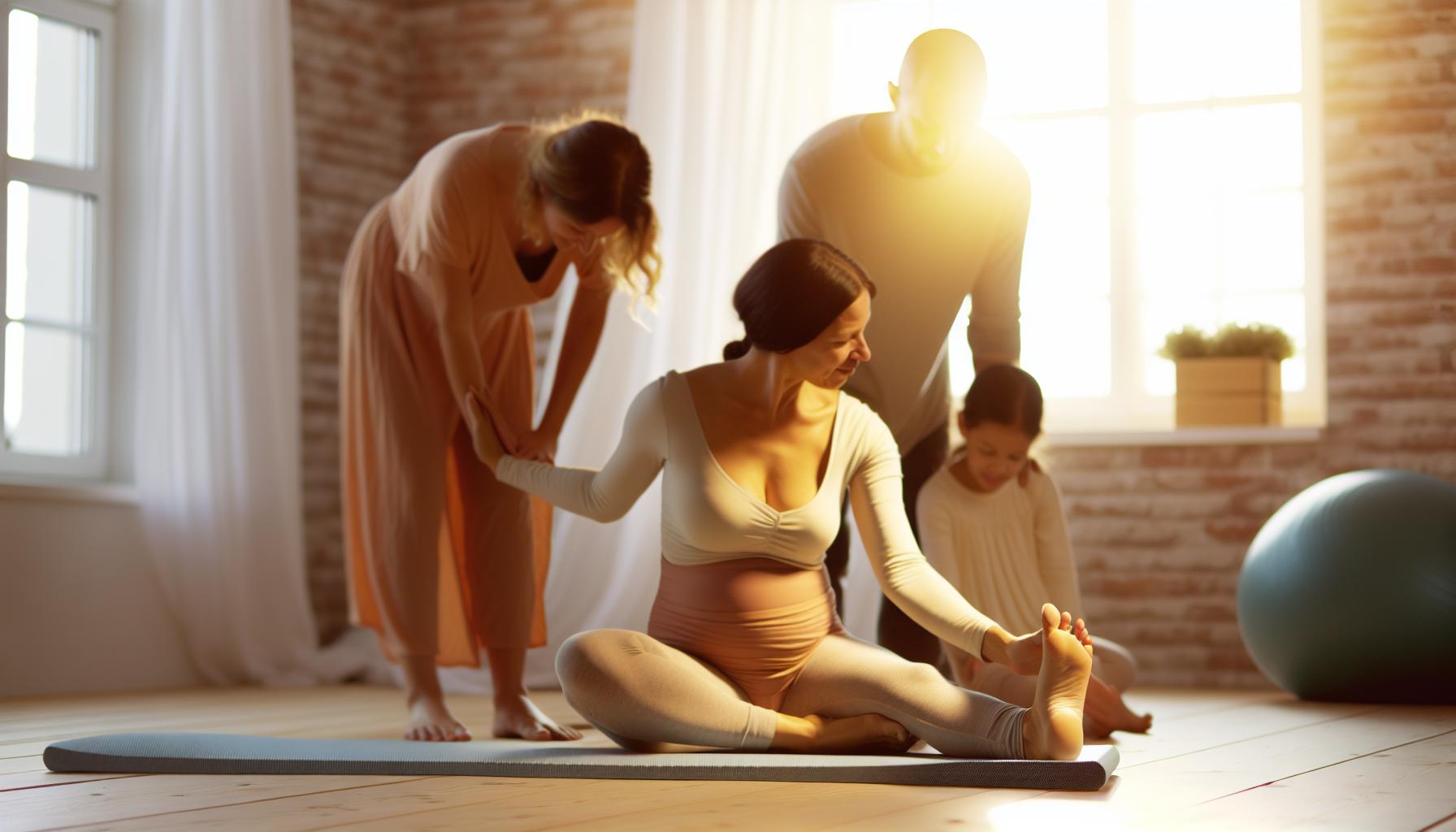After giving birth, many women experience unexpected foot pain, a condition often overlooked amidst the excitement of welcoming a new child. Understanding the causes behind this discomfort—ranging from changes in body mechanics to hormonal fluctuations—is essential for effective relief. In this article, we’ll explore practical tips to soothe sore feet and regain comfort during the postpartum journey.
Understanding the Common Causes of Foot Pain After Pregnancy
Experiencing foot pain after giving birth is a common yet often overlooked issue that many new mothers face. The body undergoes significant changes during pregnancy, and these changes can led to various discomforts, including foot pain, even after childbirth. As a woman’s body recovers and adjusts postpartum,understanding the underlying causes of foot pain becomes crucial for effective management and relief.
One of the primary contributors to foot pain after pregnancy is the weight gain that occurs during gestation. Extra weight can lead to increased pressure on the feet,causing discomfort and exacerbating existing conditions,such as plantar fasciitis. This inflammation of the tissue that runs across the bottom of the foot can result in sharp pain, especially with initial steps taken after long periods of rest. New mothers may also experience a flattening of the arches due to relaxation of ligaments and tendons, resulting in further pain and potential misalignment.
Other factors include hormonal changes that can affect connective tissue laxity and foot structure. After delivery, while the body begins to return to its pre-pregnancy state, the effects of pregnancy hormones can linger, causing instability in the ligaments of the feet. This instability can lead to overpronation, where the foot rolls inward excessively, putting undue stress on various parts of the foot and leading to chronic pain.To alleviate foot pain following childbirth, consider the following practical approaches:
- Wear supportive footwear: Opt for shoes that provide adequate arch support and cushioning. This can significantly reduce pressure on your feet.
- Gradual return to activity: Ease back into physical activities by incorporating gentle stretches and low-impact exercises designed to strengthen foot muscles.
- Consult a specialist: Seek advice from a podiatrist or physical therapist who can offer tailored exercises or orthotic solutions to address your specific foot pain.
By recognizing the common causes of foot pain after giving birth and implementing targeted relief strategies, new mothers can regain comfort and mobility, paving the way for a smoother postpartum recovery journey.
Hormonal Changes: How They Impact Your feet Post-Delivery
Understanding Hormonal Shifts
The journey of pregnancy and childbirth brings significant hormonal transformations, which can profoundly affect your foot health. During pregnancy, increased levels of relaxin and progesterone help prepare the body for labor by loosening ligaments and joints. While these hormones are beneficial for delivery, they can also lead to alterations in foot structure and function. After giving birth, as these hormonal levels return to pre-pregnancy states, many women experience some unexpected side effects, particularly regarding foot pain.
The Effects of Hormonal Changes on Feet
As estrogen levels fluctuate post-delivery, your body may undergo changes that contribute to foot discomfort. This can include:
- Loss of Arches: Relaxin can lead to fallen arches, which may cause pain in the arches of the feet or lead to other conditions such as plantar fasciitis.
- Fat Pad Shifting: Hormonal shifts can cause changes in the distribution of fat pads on the feet, potentially leading to discomfort during walking or standing.
- Weight Fluctuations: Postpartum weight changes, influenced by hormonal adjustments, can exacerbate stress on the feet, leading to increased pain.
These factors combine to create a challenging scenario for new mothers, as they adjust to both the physical demands of caring for a newborn and the aftermath of childbirth.
Practical Strategies for Relief
Managing foot pain after giving birth can frequently enough be addressed with simple yet effective strategies:
- Supportive Footwear: Invest in well-cushioned shoes that provide ample support.Avoid high heels and flat shoes that lack arch support.
- Gentle Exercises: Engage in foot-strengthening exercises, such as toe curls and calf stretches, to improve strength and flexibility.
- Cold Compresses: Apply ice packs to your feet to reduce inflammation and numb acute pain after long days of standing or walking.
- Consult Professionals: Don’t hesitate to seek advice from a podiatrist if foot pain persists. They can provide tailored exercises or recommend supportive orthotics.
With attention to foot health and proactive care, it is possible to alleviate discomfort and support your recovery during the postpartum period.
The Role of Weight Gain and Swelling in Postpartum Foot Discomfort
The Connection Between Weight Gain and Postpartum Foot Discomfort
Did you know that the average weight gain during pregnancy can significantly affect your foot health postpartum? as the body adapts to support a growing baby,the added weight places extra stress on the feet,potentially leading to discomfort long after childbirth. During pregnancy, the body produces the hormone relaxin, which increases ligament laxity—this means your feet may become flatter and wider, creating misalignment and discomfort more prone to postpartum foot pain.
In addition to weight gain, swelling is another major contributor to foot discomfort after giving birth. Fluid retention during pregnancy can lead to swollen feet and ankles, which can linger in the postpartum period. This swelling, often exacerbated by standing or walking for extended periods, can increase pressure on the foot’s ligaments and structures, intensifying pain. Here are some common factors related to weight gain and swelling that can lead to postpartum foot discomfort:
- Increased Arch Strain: The added weight can cause the arches of your feet to stretch and collapse, leading to pain and fatigue.
- Ligament Stretching: Weight gain and fluid retention can exacerbate the overstretching of ligaments, which may not have fully returned to their pre-pregnancy state.
- Inflammation: Engaging in normal postpartum activities can provoke inflammation in the feet, causing further swelling and discomfort.
practical Tips for Relief
To combat the effects of weight gain and swelling on your feet, consider these actionable steps that can definately help alleviate discomfort:
| Strategy | Description |
|---|---|
| Wear Supportive Footwear | Opt for shoes with good arch support, cushioning, and a wide toe box to accommodate any swelling. |
| hydration | Drink plenty of water to help reduce swelling; it may seem counterintuitive, but staying hydrated can definitely help flush out excess fluid. |
| Gentle Massage | Regular foot and ankle massages can stimulate circulation and reduce tension in the feet. |
| Elevation | When resting, elevate your feet to help reduce swelling and relieve pressure. |
| Regular Movement | Incorporate light stretching and exercises to keep blood flowing and prevent stiffness. |
Understanding the impacts of weight gain and swelling on your feet can help you take proactive steps to manage discomfort. With appropriate footwear, self-care practices, and awareness of your body’s needs, you can regain comfort and mobility in your feet after giving birth, enhancing your overall postpartum experience.
Practical Tips for Managing Foot Pain in New Moms
Understanding and Alleviating postpartum Foot Pain
Experiencing foot pain after giving birth is surprisingly common, with studies indicating that 44 to 61 percent of new moms report alterations in their foot size and discomfort following pregnancy [[2]]. This shift can stem from hormone-induced ligament laxity, weight gain, and changes in posture, which all contribute to a myriad of foot problems. Fortunately, there are practical strategies to ease this discomfort and promote healing.
Practical Tips for Relief
To combat postpartum foot pain, consider these actionable strategies:
- Choose Supportive Footwear: Invest in shoes that provide ample arch support and cushioning. Avoid high heels or flat shoes without support, as they can exacerbate foot pain.
- Perform Foot Exercises: Simple exercises such as toe curls, ankle rolls, and calf stretches can strengthen foot muscles and improve flexibility. Try to dedicate a few minutes daily to foot workouts.
- Practice Rest and elevation: Whenever possible, sit down and elevate your feet with a cushion or ottoman.This can help reduce swelling and relieve pressure on your feet.
- Utilize Cold and Heat Therapy: Apply ice packs to swollen or painful areas for 15-20 minutes to reduce inflammation. After the acute pain subsides, switching to warm foot baths can promote relaxation and blood flow.
- Consult a Physical Therapist: If pain persists,seeking professional help can be beneficial. A therapist can customize exercises and treatments specific to your needs, helping restore function and ease discomfort.
Nurturing Your Feet
Taking proactive measures to care for your feet post-pregnancy is essential for your overall well-being. By understanding the causes and implementing these practical tips, moms can reclaim their comfort and continue focusing on the rewarding journey of motherhood. Whether you’re handling sleepless nights or managing a busy schedule, your feet need their share of love too. Incorporating supportive habits into your daily routine will not only help mitigate foot pain but also empower you to enjoy your time with your newborn more fully.
Exercises and Stretches to Alleviate Post-Birth Foot Pain
Gentle Foot Exercises to Promote Healing
After the physical demands of pregnancy and childbirth, it’s common for many new mothers to experience foot pain and discomfort. Incorporating gentle exercises into your routine can help alleviate these symptoms and foster recovery. Here are some effective exercises designed to strengthen the feet and improve flexibility:
- Toe Grabs: Sit comfortably with your feet flat on the floor. Place a small towel on the ground in front of you. Using your toes, try to grab the towel and pull it toward you. This exercise engages your foot muscles and helps improve grip strength.
- Heel Raises: Stand with your feet hip-width apart. Slowly lift your heels off the ground, rising onto your toes. Hold this position for a few seconds before lowering back down. Repeat this 10-15 times to strengthen your calves and support your arches.
- Arch Stretch: Sit on a chair and place your right foot over your left knee. Using your fingers, gently pull the toes back towards your shin to stretch the arch of your foot. Hold for 15-30 seconds and switch feet. This stretch can alleviate tightness and discomfort caused by changes during pregnancy.
Stretches for Overall Foot Relief
Stretches are crucial for recovering from foot pain after giving birth. Here are some effective techniques that can ease tension and improve overall foot health:
- Calf stretch: Stand facing a wall. Place your hands against the wall and step one foot back. Keep your back heel on the ground and bend your front knee. You shoudl feel a stretch in the calf of your back leg. hold for 15-30 seconds and switch sides.
- Seated Foot stretch: While seated,extend one leg in front of you and flex your foot,pulling your toes toward you. Hold for a count of five and then point your toes away. Repeat this several times for both feet to enhance flexibility.
Incorporating These Practices into Daily Life
Integrating these exercises and stretches into your daily routine can significantly help combat foot pain after giving birth. Aim to perform them at least once or twice a day, ideally during moments of downtime, such as while watching TV or taking a breather during chores. As you become familiar with these movements, you may find that they not only relieve discomfort but also contribute to your overall sense of well-being and mobility post-pregnancy.
Equipping yourself with knowledge about effective strategies to tackle foot pain is essential. By being proactive with exercises and stretches, you empower your body to heal and adapt to the changes of motherhood. For more comprehensive strategies to alleviate foot discomfort and promote healing post-birth, continue exploring additional resources and tips tailored to new mothers.
Choosing the Right Footwear: A Simple Guide for New Mothers
Understanding Your Footwear Needs After Pregnancy
After giving birth,many new mothers experience physical changes that can affect their feet,leading to discomfort or even foot pain. Foot pain after giving birth is a common concern due to factors like hormonal changes, weight fluctuations, and alterations in foot structure. Choosing the right footwear during this period is crucial not only for managing pain but also for supporting your overall physical well-being as you navigate the challenges of motherhood.When selecting shoes, prioritize comfort and support to alleviate discomfort. Look for footwear with the following features:
- Arch Support: Shoes with good arch support help distribute weight evenly and can significantly reduce foot pain.
- Cushioning: Opt for cushioned soles that absorb shock, making it easier to stay on your feet for longer periods.
- Wide Toe Box: A spacious toe box accommodates foot swelling and deformities, preventing conditions like bunions from worsening.
- Adjustability: Shoes with adjustable straps or laces can provide a customized fit as your feet may continue to change size and shape.
Tips for Finding the Perfect Fit
To ensure that your new shoes are the right size, consider measuring your feet later in the day when they are most likely to be swollen. according to research,a significant portion of the population wears incorrect shoe sizes,leading to various foot disorders [2[2]. Here are some practical strategies to help you find the perfect footwear:
- Get Professionally Measured: Visit a shoe store that offers professional fitting services. this can ensure you get the right width and length.
- Try Before You Buy: Always try on shoes with the type of socks you plan to wear. Walk around the store to assess comfort and support.
- Consult a Specialist: If foot pain persists, consider consulting a pedorthist or podiatrist to explore orthotic options that can be incorporated into your shoes <a href="https://www.cdc.gov/steadi/media/pdfs/2024/08/STEADIFeetFootwearGuideO.pdf”>[1[1].
recommended Footwear Types
Certain types of shoes can provide the best support for new mothers dealing with foot pain post-pregnancy. consider these options:
| Type of footwear | Benefits |
|---|---|
| Walking Shoes | Designed for comfort and support during long walks,with adequate cushioning and arch support. |
| Sandals | Choose styles with arch support and adjustable straps to accommodate swelling. |
| Slip-ons | Easy to wear and remove, but should still provide proper support and cushioning. |
| Boots | Look for those with good arch support; they provide ankle stability, which can help if you have a tendency to roll your ankles. |
By prioritizing comfort and support with the right footwear, new mothers can manage foot pain after giving birth more effectively. Remember that investing in high-quality shoes is an essential step in caring for your overall health and enjoyment of this new chapter of life.
When to Seek Professional Help for Persistent Foot Pain After Childbirth
After childbirth, many women experience various physical changes, and foot pain is surprisingly common. The combination of hormonal shifts, weight gain, and altered biomechanics can contribute to discomfort in the feet. However, understanding when to seek professional help for this persistent foot pain is crucial for recovery and well-being.
Signs that Indicate Professional Assistance Is needed
While some foot pain may resolve with time and self-care, there are distinct signs that suggest it’s time to consult a specialist. If you notice any of the following symptoms, it may be prudent to seek professional evaluation:
- Persistent pain that doesn’t improve with rest or basic home care.
- Swelling that lasts more then a few days or occurs alongside redness and warmth.
- Difficulty walking or standing without significant discomfort.
- Sharp or stabbing pain that disrupts daily activities.
- Numbness or tingling in the foot, which can indicate nerve involvement.
Potential Underlying Conditions
Persistent foot pain after childbirth could be indicative of underlying issues that may require medical intervention. Conditions such as plantar fasciitis, heel spurs, or even stress fractures can develop due to the increased demands placed on the feet during pregnancy and delivery. Left untreated, these issues may lead to chronic pain and complications. If foot pain persists despite conservative measures such as over-the-counter pain relievers and rest, consulting a podiatrist or orthopedic specialist is advisable.
Treatment Options and Next steps
Upon visiting a professional, expect a comprehensive evaluation that may include a physical examination and imaging tests. Based on the diagnosis, treatment options could range from physical therapy and orthotic devices to more invasive procedures in severe cases. Early intervention not only speeds up recovery but also helps in preventing long-term complications associated with untreated foot pain.
Embracing Self-Care: Prioritizing Your Feet in the Journey of Motherhood
Every new mother experiences a transformative journey that brings joy, challenges, and a shift in priorities. Among the many physical changes that occur postpartum, foot pain is a common yet often overlooked issue. As the body adapts to carrying and caring for a newborn, the alignment and support of your feet can suffer, leading to discomfort that may linger well after childbirth. This is not just a minor inconvenience—it’s a signal to embrace self-care and prioritize your foot health during this crucial time.
Understanding the causes of foot pain after giving birth can empower you to take action and minimize discomfort. Factors such as hormonal changes, increased weight, and altered walking patterns can all contribute to painful conditions like plantar fasciitis or general foot pain. To combat these issues, consider incorporating daily foot care into your routine. Simple practices, such as warm foot soaks and gentle massages, can be effective in relieving tension and promoting relaxation. A regular routine can also include stretching exercises that target your arches and calves, supporting the changes your feet have undergone.
- incorporate Foot Soaks: Soak your feet in warm water with Epsom salt to soothe aches.
- Practice Foot Stretches: stretch your arches and calves to alleviate tightness.
- Invest in Proper Footwear: Choose supportive shoes that provide ample room for your feet to breathe, especially if you notice your shoe size has changed postpartum.
- Use Orthotic Inserts: These can help in distributing your weight more evenly and providing better arch support.
To help mothers manage foot pain effectively, consider maintaining a log of your foot health. This table format may assist in tracking pain levels, activities, and effective relief methods:
| Date | Pain Level (1-10) | Activity | Relief Method Used |
|---|---|---|---|
| April 1 | 7 | Walking with baby in stroller | Foot soak and ice pack |
| April 2 | 5 | Indoors, light housework | Stretching and massage |
| April 3 | 4 | Sitting with baby | Rest and elevating feet |
By observing your foot health patterns, you can identify triggers and effective relief methods, creating a proactive approach to managing foot pain after giving birth. Remember, nurturing your feet is an essential aspect of self-care that allows you to focus on your new role as a mother. Taking these small yet significant steps can lead to better physical well-being and a more enjoyable motherhood experience.
FAQ
What causes foot pain after giving birth?
Foot pain after giving birth can arise from several factors, including hormonal changes, weight gain during pregnancy, and physical stress on the feet. These changes often affect the *alignment and support* of the feet.
During pregnancy, the body produces the hormone relaxin, which relaxes ligaments in preparation for childbirth.This can lead to *instability* in the foot’s arches, resulting in pain. Additionally, the increase in body weight and the impact of carrying a baby can put extra pressure on the feet, exacerbating discomfort after delivery. For more on related concerns, you may explore our article on *post-pregnancy body changes*.
How can I relieve foot pain after giving birth?
Relieving foot pain after giving birth can involve several strategies,such as elevating your feet,using supportive footwear,and gentle stretching exercises.
It’s essential to prioritize rest whenever possible, as your body is recovering. Wearing shoes that provide adequate support can significantly decrease foot pain. Additionally, simple stretches and exercises targeting the foot muscles may help improve flexibility and reduce tension. Techniques such as soaking your feet in warm water or using ice packs can also provide temporary relief.
Why dose my foot pain feel worse at night after giving birth?
Foot pain may intensify at night due to accumulated fatigue throughout the day and reduced activity levels, which can lead to stiffness.
As you navigate the demands of caring for a newborn, it’s common to experience fatigue in your feet. This can be particularly noticeable at night when you’re finally resting. Engaging in light stretching before bed might help alleviate some discomfort and encourage relaxation. In some cases, discussing persistent pain with your healthcare provider is beneficial to ensure proper healing.
Can stretching help with foot pain after giving birth?
Yes, stretching can significantly help alleviate foot pain after giving birth by improving flexibility and relieving tension in the muscles.
Incorporating stretching exercises into your daily routine can strengthen the foot muscles and enhance circulation. Focus on stretches that target the calves, arches, and toes. Simple yoga moves, such as *downward dog*, can also benefit the feet. Regular stretching not only helps with current symptoms but can also prevent further discomfort in the long run.
What shoe types are best for foot pain after giving birth?
The best shoe types for foot pain after giving birth are those that provide firm arch support,cushioning,and stability.
Avoid high heels or flat shoes that lack support, as they can strain your feet further. Look for *orthopedic shoes* or brands known for comfort and support. Additionally, using custom insoles can provide additional cushioning for your feet during the recovery phase.Taking care of your foot health is critical as your body heals, ensuring you can tackle parenting challenges comfortably.
When should I see a doctor about foot pain after giving birth?
You should see a doctor about foot pain after giving birth if the pain is severe,persistent,or accompanied by swelling or redness.
If home remedies and lifestyle changes do not alleviate your foot pain after several weeks, it might potentially be time to consult a healthcare professional. They can help identify any underlying conditions causing your pain and recommend specialized treatments. *Additional consultation* can also provide reassurance and targeted interventions that can significantly improve your comfort.
What are the long-term effects of foot pain after giving birth?
Long-term effects of foot pain after giving birth can include ongoing discomfort, structural changes in the feet, or conditions like plantar fasciitis.
Without proper care and attention, some mothers may experience chronic pain or develop problems like *flat feet* or tendonitis over time. It’s essential to address foot pain early by incorporating preventive measures such as supportive footwear and regular stretching to mitigate long-lasting issues.Staying proactive about your foot health is key to enjoying your parenting journey.
to sum up
as you navigate the postpartum journey, it’s essential to acknowledge the changes your body has undergone, particularly regarding foot pain. This discomfort can stem from overstretched ligaments and water retention,making it a common issue many new parents face. Understanding these causes empowers you to take control of your recovery. By taking proactive steps like wearing supportive shoes, practicing gentle foot massages, and considering anti-inflammatory measures, you can alleviate some of the pain and discomfort.
Remember, you are not alone in this experience. Embracing self-care during this transitional time is crucial,not just for your well-being but also for your ability to care for your little one. Explore more about managing postpartum challenges, and don’t hesitate to reach out for professional help if needed. Your health matters, and with the right support and data, you can find relief and regain comfort in your everyday life. For more tips and insights, continue exploring our resources tailored for new parents like you.








